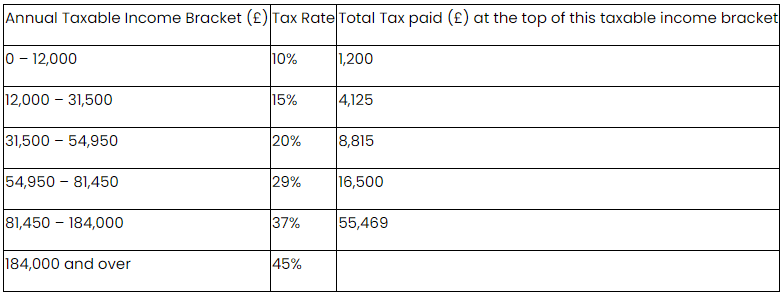Tax Related Practice Questions | Quantitative Reasoning for UCAT PDF Download
Q.1. The table shows the total tax paid (£) on annual taxable income.
For example, a person with an annual taxable income of £45,000 will pay £4,125 plus 20% of (£45,000 – £31,500).
Q. Ruoxuan has an annual taxable income of £23,330. The income tax, to the nearest £, he has to pay is:
(a) £1,700
(b) £2,333
(c) £2,900
(d) £3,466
(e) £5,825
Correct Answer is Option (c)
£23,300 fits into the second tax bracket… £12,000 gets taxed at 10%, yielding £1,200 (as shown in the RH column)
The remaining (£23,330 – £12,000) = £11,330 gets taxed at 15%, yielding £1,699.50 – adding this to £1,200 makes £2,900 (4sf)
Q.2. The table shows the total tax paid (£) on annual taxable income.
For example, a person with an annual taxable income of £45,000 will pay £4,125 plus 20% of (£45,000 – £31,500).
Q. Olenka has an annual taxable income of £114,050. The income tax she has to pay is:
(a) £25,954
(b) £28,562
(c) £31,170
(d) £38,367
(e) £5,825
Correct Answer is Option (b)
£114,050 fits into the fifth tax bracket:
The RH column shows that the first £81,450 yields £16,500 tax;
Then, the remaining (£114,050 – £81,450) = £32,600 gets taxed at 37%, yielding £12,062 and thus a total of £28,562
Q.3. The table shows the total tax paid (£) on annual taxable income.
For example, a person with an annual taxable income of £45,000 will pay £4,125 plus 20% of (£45,000 – £31,500).
Q. Ruoxuan has an annual taxable income of £23,330. The income tax, to the nearest £, he has to pay is:
(a) £49,040
(b) £55,290
(c) £58,150
(d) £59,040
(e) £60,880
Correct Answer is Option (d)
If Max pays £10,000 tax per year, his income must lie in the fourth tax bracket (i.e. he earns £54,950 to £81,450).
£10,000 – £8,815 = £1,185, which must have come from £1,185/0.29 = £4,086.21 (2dp). Adding this to £54,950 gives £59,040 (5sf)
Q.4. The table shows the total tax paid (£) on annual taxable income.
For example, a person with an annual taxable income of £45,000 will pay £4,125 plus 20% of (£45,000 – £31,500).
Q. Marie-Jo has an annual taxable income equivalent to £4,000 per month. If she wants to save enough money each month to cover her tax for the year, how much must she save as a rough percentage of her monthly income?
(a) 7.7%
(b) 9.4%
(c) 12.1%
(d) 15.5%
(e) 15.5%
Correct Answer is Option (d)
£4,000 per month = £48,000 per year, i.e. 3rd tax bracket
Tax for the year = £4,125 + [ 20% x (£48,000 – £31,500) ] = £4,125 + 20% x 16,500 = £4,125 + 3,300 = £7,425
Percentage of income = (£7,425 / £48,000) x 100 = 15.5% (3sf)
Q.5. The table shows the total tax paid (£) on annual taxable income.
For example, a person with an annual taxable income of £30,000 will pay £895 plus 15% of (£30,000 – £8,950).
Q. Lucia pays £1,900 per month in income tax. To the nearest £10, what is her annual salary, after tax is deducted?
(a) £82,590
(b) £83,590
(c) £84,590
(d) £85,590
(e) £86,590
Correct Answer is Option (a)
Annual tax paid within 4th bracket = (£1,900 x 12) – £17,890 = £4,910
Income within 4th bracket = £4,910 / 0.28 = £17,535.71 (2dp)
Post-tax Salary = (£87,850 + £17,535.71) – £22,800 = £82,585.71 (2dp) = £82,590 to the nearest £10
Q.6. The table shows the total tax paid (£) on annual taxable income.
For example, a person with an annual taxable income of £30,000 will pay £895 plus 15% of (£30,000 – £8,950).
Q. Ezra pays £1,450 per month in income tax. What is his annual taxable income?
(a) £68,490
(b) £72,840
(c) £77,190
(d) £81,540
(e) £85,890
Correct Answer is Option (e)
Annual tax = £1,450 x 12 = £17,400, i.e. in 3rd tax bracket
Tax paid within 3rd bracket = £17,400 – £4,990 = £12,410
Income within 3rd bracket = £12,410 / 0.25 = £49,640
Total income = £36,250 + £49,640 = £85,890
Q.7. The table shows the total tax paid (£) on annual taxable income.
For example, a person with an annual taxable income of £30,000 will pay £895 plus 15% of (£30,000 – £8,950).
Q. Delilah is promoted at work, and her salary rises from £80,000 to £90,000 pre-tax. By how much does the amount of tax she pays change?
(a) £1359.50
(b) £2500.00
(c) £2564.50
(d) £2672.00
(e) £10335.50
Correct Answer is Option (c)
Old tax = £4,990 + [ 25% x (£80,000 – £36,250) ] = £15,927.50
New tax = £17,890 + [ 28% x (£90,000 – £87,850) ] = £18492
Increase = £18492 – £15927.50 = £2564.50
Q.8. The table shows the total tax paid (£) on annual taxable income.
For example, a person with an annual taxable income of £30,000 will pay £895 plus 15% of (£30,000 – £8,950).
Q. Last year, Helga paid £9,166 per month in income tax. After tax deductions, how much did she earn in the year, to the nearest £?
(a) £54,661
(b) £204,289
(c) £234,910
(d) £238,384
(e) £271,410
Correct Answer is Option (e)
Annual Tax within 5th bracket = (£9,166 x 12) – £44,602 = £65,390
Income within 5th bracket = £65,390 / 0.33 = £198,151.52
Post-tax income = (£183,250 + £198,151.52) – (£9,166 x 12) = £271,409.52 (2dp) = £271,410 to the nearest £
Q.9. The table shows the total tax paid ($) on annual taxable income.
For example, a person with an annual taxable income of $30,000 will pay $1,440 plus 16% of ($30,000 – $12,000).
Q. Leanne earns $63,000 a year. How much income tax does she pay?
(a) $5,593.60
(b) $9,600.00
(c) $10,732.80
(d) $12,660.00
(e) $13,187.20
Correct Answer is Option (c)
Total Tax = $6,579.20 + [ 22% x ($63,000 – $44,120) ]
= $6,579.20 + (22% x $1,880) = $6,579.20 + $4,154
= $10,732.80
Q.10. The table shows the total tax paid ($) on annual taxable income.
For example, a person with an annual taxable income of $30,000 will pay $1,440 plus 16% of ($30,000 – $12,000).
Q. Symala earns $23,158 a year. How much income tax does she pay?
(a) $2,778.96
(b) $3,225.28
(c) $3,241.28
(d) $4,096.28
(e) $5,145.28
Correct Answer is Option (b)
Total Tax = $1,440 + [ 16% x ($23,158 – $12,000) ]
= $1,440 + (16% x $11,158) = $1,440 + $1,785.28
= $3,225.28
|
34 videos|17 docs|16 tests
|

|
Explore Courses for UCAT exam
|

|

















